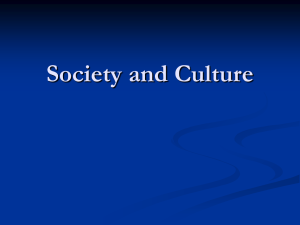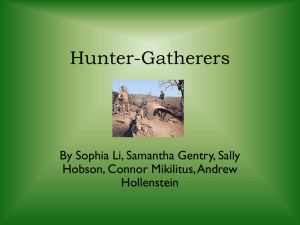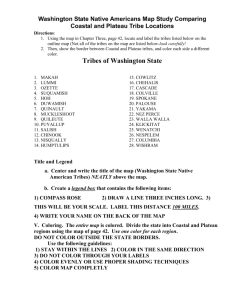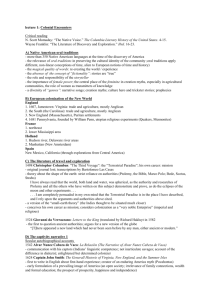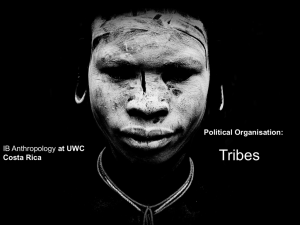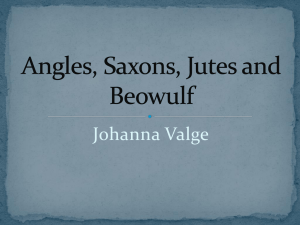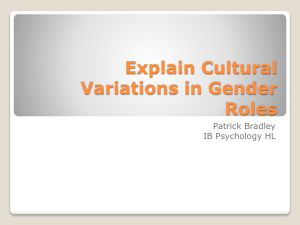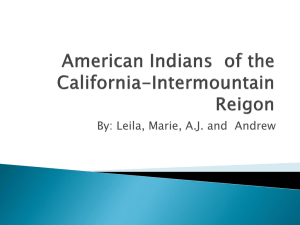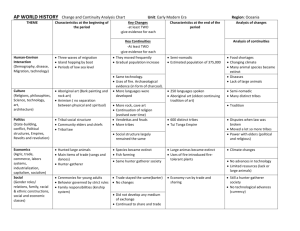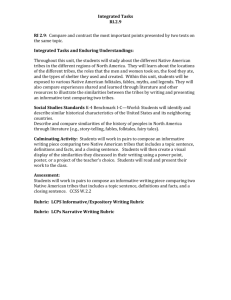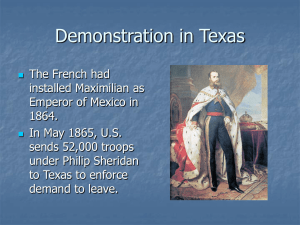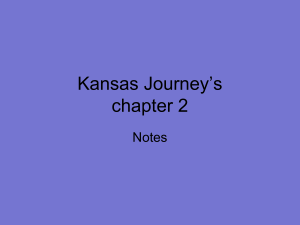lecture 2: The Invention of America: Colonial encounters
advertisement
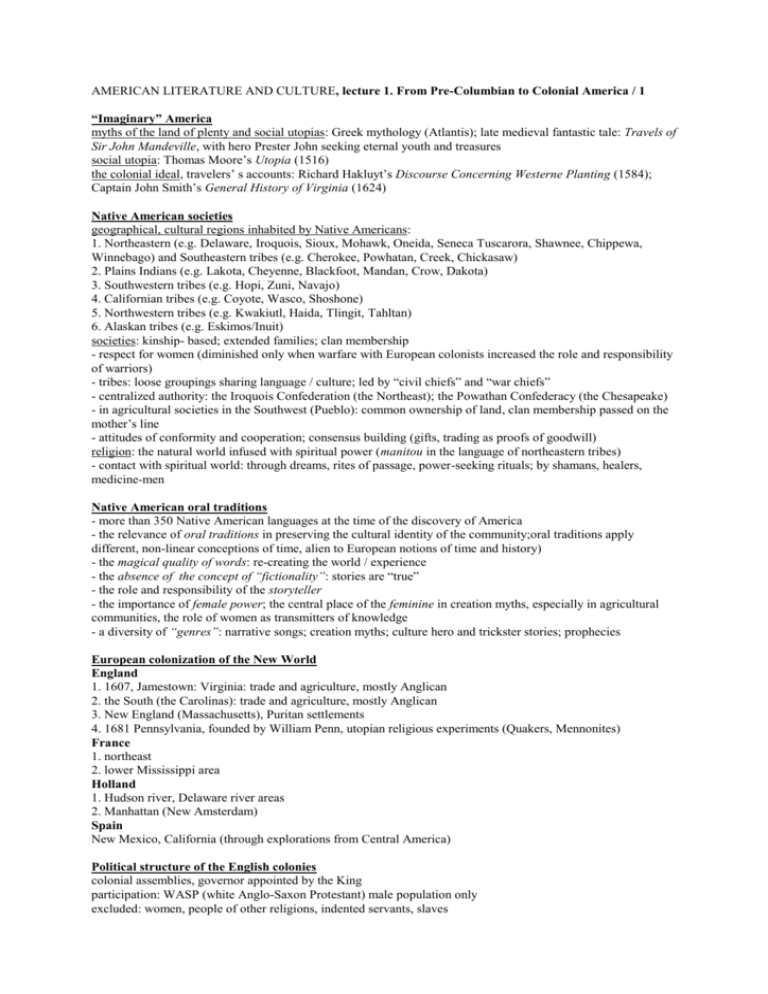
AMERICAN LITERATURE AND CULTURE, lecture 1. From Pre-Columbian to Colonial America / 1 “Imaginary” America myths of the land of plenty and social utopias: Greek mythology (Atlantis); late medieval fantastic tale: Travels of Sir John Mandeville, with hero Prester John seeking eternal youth and treasures social utopia: Thomas Moore’s Utopia (1516) the colonial ideal, travelers’ s accounts: Richard Hakluyt’s Discourse Concerning Westerne Planting (1584); Captain John Smith’s General History of Virginia (1624) Native American societies geographical, cultural regions inhabited by Native Americans: 1. Northeastern (e.g. Delaware, Iroquois, Sioux, Mohawk, Oneida, Seneca Tuscarora, Shawnee, Chippewa, Winnebago) and Southeastern tribes (e.g. Cherokee, Powhatan, Creek, Chickasaw) 2. Plains Indians (e.g. Lakota, Cheyenne, Blackfoot, Mandan, Crow, Dakota) 3. Southwestern tribes (e.g. Hopi, Zuni, Navajo) 4. Californian tribes (e.g. Coyote, Wasco, Shoshone) 5. Northwestern tribes (e.g. Kwakiutl, Haida, Tlingit, Tahltan) 6. Alaskan tribes (e.g. Eskimos/Inuit) societies: kinship- based; extended families; clan membership - respect for women (diminished only when warfare with European colonists increased the role and responsibility of warriors) - tribes: loose groupings sharing language / culture; led by “civil chiefs” and “war chiefs” - centralized authority: the Iroquois Confederation (the Northeast); the Powathan Confederacy (the Chesapeake) - in agricultural societies in the Southwest (Pueblo): common ownership of land, clan membership passed on the mother’s line - attitudes of conformity and cooperation; consensus building (gifts, trading as proofs of goodwill) religion: the natural world infused with spiritual power (manitou in the language of northeastern tribes) - contact with spiritual world: through dreams, rites of passage, power-seeking rituals; by shamans, healers, medicine-men Native American oral traditions - more than 350 Native American languages at the time of the discovery of America - the relevance of oral traditions in preserving the cultural identity of the community;oral traditions apply different, non-linear conceptions of time, alien to European notions of time and history) - the magical quality of words: re-creating the world / experience - the absence of the concept of “fictionality”: stories are “true” - the role and responsibility of the storyteller - the importance of female power; the central place of the feminine in creation myths, especially in agricultural communities, the role of women as transmitters of knowledge - a diversity of “genres”: narrative songs; creation myths; culture hero and trickster stories; prophecies European colonization of the New World England 1. 1607, Jamestown: Virginia: trade and agriculture, mostly Anglican 2. the South (the Carolinas): trade and agriculture, mostly Anglican 3. New England (Massachusetts), Puritan settlements 4. 1681 Pennsylvania, founded by William Penn, utopian religious experiments (Quakers, Mennonites) France 1. northeast 2. lower Mississippi area Holland 1. Hudson river, Delaware river areas 2. Manhattan (New Amsterdam) Spain New Mexico, California (through explorations from Central America) Political structure of the English colonies colonial assemblies, governor appointed by the King participation: WASP (white Anglo-Saxon Protestant) male population only excluded: women, people of other religions, indented servants, slaves Colonial economy 1. the Northern Colonies (New England, New Hampshire, Rhode Island): joint stock companies (investors: shareholders, received dividends), fishing, trade, craftsmanship 2. the Middle Colonies (New York, New Jersey, Delaware, Pennsylvania): settler proprietors, agriculture 3. the South (Maryland, Virginia, North Carolina): single-crop plantations (tobacco, rice, cotton), slave labor 4. the West Indies (Barbados, Jamaica): sugar plantations, slave labor The literature of travel and exploration 1498 Christopher Columbus: “The Third Voyage”: the “Terrestrial Paradise”; his own career: mission - original journal lost; transcriptions by Bartolomeo Las Casas - theory about the shape of the earth: strict reliance on authorities (Ptolemy, the Bible, Marco Polo; Bede, Scotus, Strabo) I have always read that the world, both land and water, was spherical, as the authority and researches of Ptolemy and all the others who have written on this subject demonstrate and prove, as do the eclipses of the moon and other experiments . . . . . . I am completely persuaded in my own mind that the Terrestrial Paradise is in the place I have described, and I rely upon the arguments and authorities above cited. - a version of the “small-earth theory” (the Indies thought to be situated much closer) - conceives his own career as mission; considers colonization as a “very noble Enterprise” (imperial and religious) 1524 Giovanni da Verrazzano: Letters to the King (translated by Richard Hakluyt in 1582 - the first to question ancient authorities; argues for a new version of the globe “[T]here appeared a new land which had never been seen before by any man, either ancient or modern.” The secular captivity narrative 1542 Alvar Nunez Cabeza de Vaca: La Relación (The Narrative of Alvar Nunez Cabeza de Vaca) - communication with his captors (Indians’ linguistic competence; not inarticulate savages; account of the difference in dialects); enlightened but determined colonizer 1624 Captain John Smith: The Generall Historie of Virginia, New England, and the Summer Isles - first to write in English about first-hand experience; creator of an enduring America myth (Pocahontas) - early formulation of a prevailing image of America (an open society; irrelevance of family connections, wealth and formal education; the prospect of prosperity, happiness and independence)
